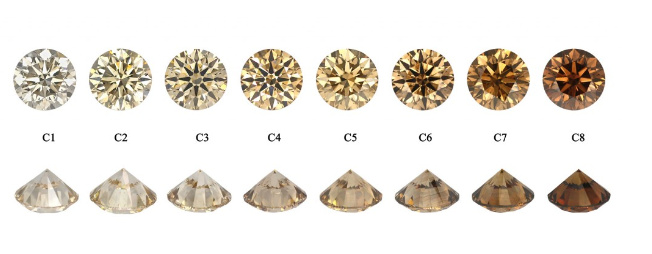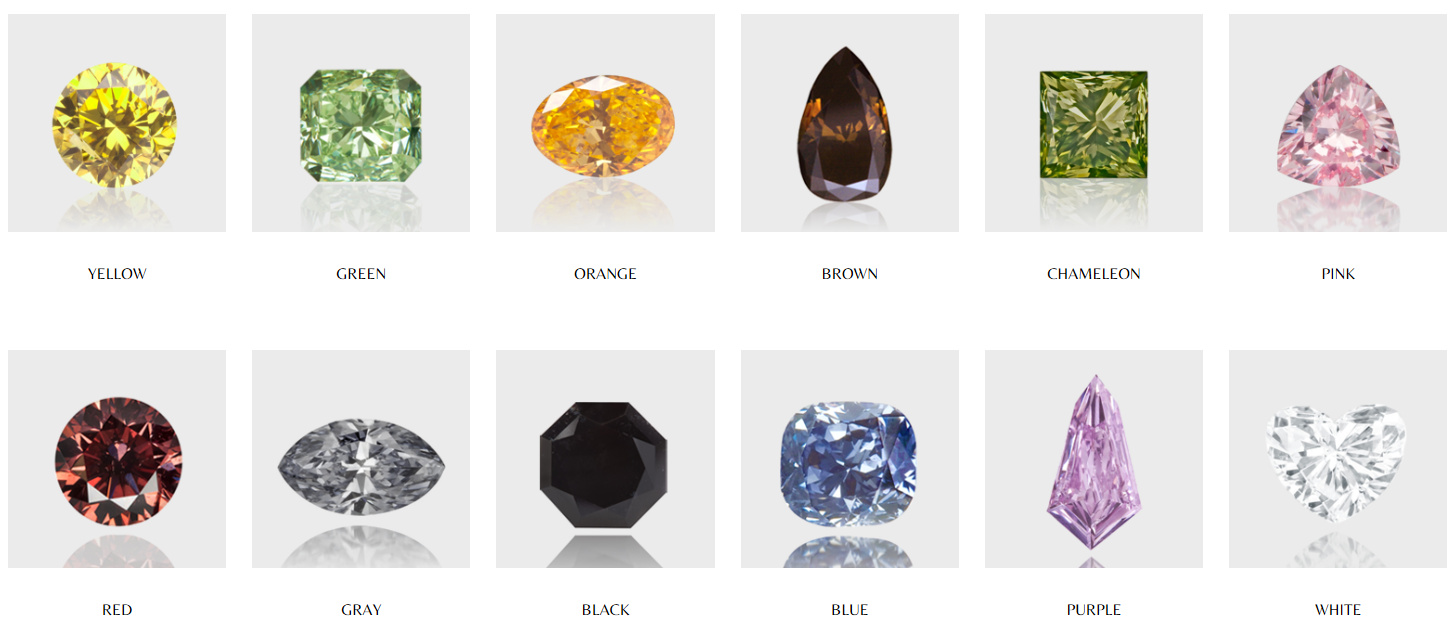Diamond Colour
Diamonds come in a variety of colours and the most popular for jewellery are the white series of diamonds.
The most rare and sought after diamonds are colourless and demand the highest price. So how do we colour grade a diamond? The Gemological Institute of America is the worlds largest and most trusted diamond grading facility and they invented the diamond colour grading scale. The highest and ost colourless diamond is known as a D colour so the scale starts here. Diamonds that show no colour are known as colourless and these include D-E-F colours. Diamonds that are near colourless show a very tiny hint and they include G-H-I-J. Here at Polished Diamonds we sell mainly D-J colours but the scale goes right down to Z which shows significant colour - see the scale below.

The vast majority of gem quality diamonds are represented in the above colour scale that goes from colourless D to taking on yellow or brown overtones of colour down to the Z. So as diamonds take on more yellow colour they start to become less sought after and become less expensive. You can view in the above image that the scale is very subtle and gradule indeed and its not until J-K-L and with direct comparison that the yellow tint can start to show.
We recommend clients buy the diamond quality that best fits there needs and budget. If you are buying a ring made in Platinum then a D-E-F are best suited as these are colourless and will not take on any reflection from yellow gold. If you are wanting diamond size and are limited on budget the G-H-I represent excellent value and these can also be set in Platinum and look fabulous (I set a G colour in Platinum - look amazing). So the G-H-I colours represent good value and the D-E-F colours represent a very high quality at a slightly higher price - as you can see in the above graphic the difference is very insignificant. If you are looking to use yellow gold we recommend using G-H-I as you will get some colour reflection from the yellow gold and use J colour to get the size up if your budget is tight. We find that diamonds in the K-L-M spectrum do show faint yellow colours and we prefer not to advertise these for sale as the sparkle and performance can be reduced.
Once diamonds reach the Z colour in the white series they then start to take on a different colour scale. We know these diamonds as Champagne and Cognac diamonds. Champagne diamonds are known as C1-C2-C3 and when more brown is added they become C4 to C8. Check the below colour chart to see the subtle change in colour.

The Champgne and Cognac diamonds series above are much less expensive than the white diamond series and offer both excellent value to increase the size but also add a different dimension as the colour is quite visible. Some of our clients like the idea of combining a darker Cognac diamond in the centre with a halo or circle of white diamonds around to frame it up. This can be done on a more subtle basis using the C1-C3 Champagne series and they do look good and a valid alternative. Contact us to quote and prepare a viewing of these remarkable diamonds.
The above mentioned diamond colours are the most popular but we also have available other colours like pink, blue, fancy yellow and other items. These diamonds are quite rare and very sought after so perhaps contact us for information about what is available and we'll match your budget.
Black diamonds are inexpensive as are the brown (Cognac) with Champagne and white diamonds next. Fancy yellow diamonds are similar in price to fine white diamonds and form the next price category. Pink, Blue, Red, Grey, Purple, Green are very expensive with pricing often around $30,000 for 1/2 carat on an average colour score. The more intense the colour the higher the price. Contact us for information on these fancy colours but do consider that because these diamonds are so rare and in short supply they are collectable with only up to 80 carats per year for world wide production - the prices are very high but do appreciate. The fancy diamond colours have GIA certification to confirm the colour is natural and usually evenly dispersed across the stone. With trusted and reliable documentation from the GIA you will be buying an appreciating and remarkable gem stone.




FaceBook Twitter YouTube Google Instagram pinterest